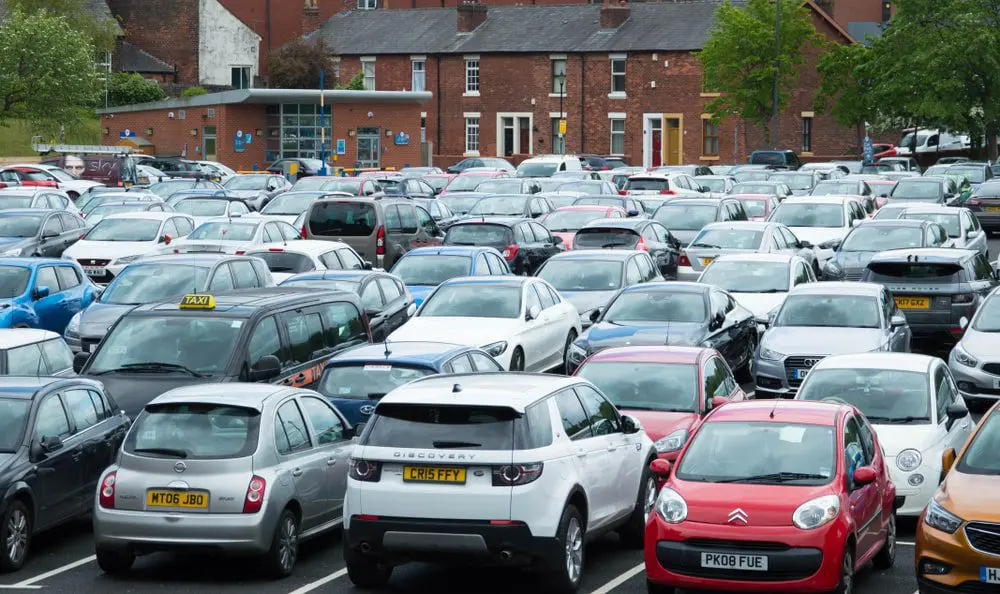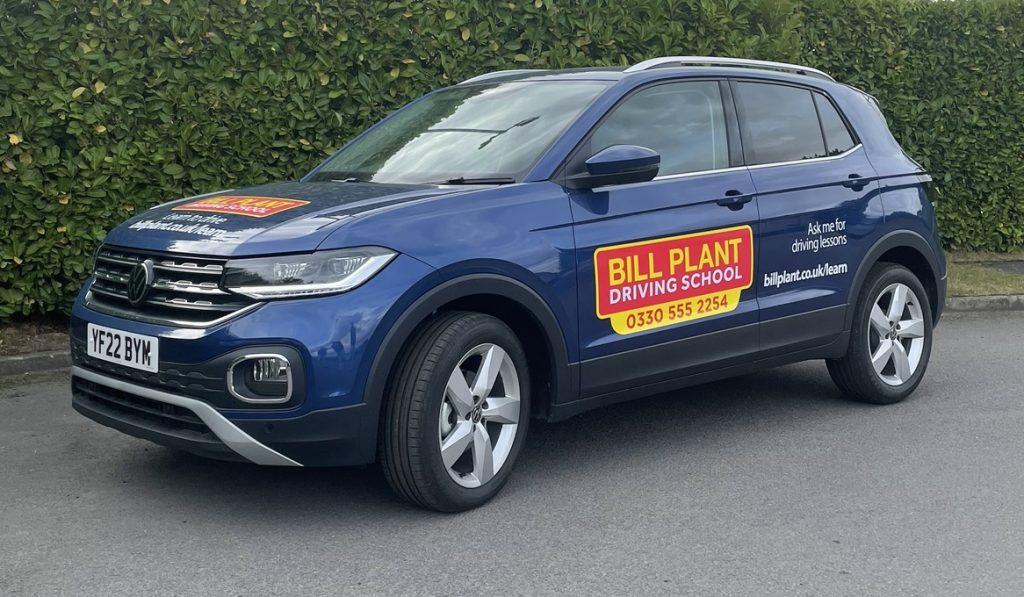Whether it’s parallel parking or parking in a bay, learning to perform manoeuvres is one of the most crucial parts of learning to drive. Many drivers are slightly daunted by this, as it can be a bit tricky when you’re just starting out. However, it’s one of the basics that everyone needs to master.
In our series on the basics of driving, we’ve covered how to start a car, move off and stop, how to set up a car seat and car gears – just to name a few. This time, we’ve taken an in-depth look at how to park in a bay safely and confidently.
At Bill Plant Driving School, we teach thousands of people to drive every year, so we know a thing or two about performing manoeuvres. Our expert guide will give you all the tips and advice you need to be well prepared for your first driving lessons.
So, buckle up, and let’s get started.
What is bay parking?

Bay parking is an important manoeuvre that all drivers need to learn. To put it simply, bay parking is reversing or driving forward into a parking bay.
It may sound straightforward, but learning the basic techniques of bay parking will help you perform this manoeuvre safely and efficiently every time.
We recommend reversing into a parking bay when possible. This means you’ll leave the parking space driving forward, making it safer, easier and faster.
However, it won’t always be possible to do this, so you must be familiar with reverse and forward bay parking.
Why do you need to know how to bay park?
You must learn how to bay park as there is a 1-in-3 chance you’ll have to perform this manoeuvre when you take your practical driving test.
Your examiner will watch closely to ensure you show good judgement and maintain control of the vehicle throughout the bay parking manoeuvre. You’ll be marked down if you don’t consistently perform checks and observations, so you need to be wary of this.
When you’re out and about driving, you’ll likely be using car parks on a regular basis. So, you must know how to park in them properly.
During your test, typically at either the start or the end, the examiner will tell you whether they want you to perform a forward bay park or a reverse bay park, and they’ll give you plenty of warning to give you time to prepare.
How to forward bay park
Choose your bay
As you’re entering the car park, take your time to choose a bay to park in. You can choose one to the left or the right, but it’s usually best to find one on the right to have enough room to manoeuvre. For that reason, we’ll assume you’ve chosen a bay on the right.
It’s much easier to park in a space with no cars on either side. Make sure to keep an eye out for any markings or signs that might indicate you’re not allowed to park in a particular parking bay.
Find your reference point
Start by identifying available spaces. Once you’ve done so check your interior mirror, right-wing mirror and blind spots.
The next step is to choose your bay. Having made sure there is no oncoming traffic, you should put on your right indicator and slowly move over to the left to allow as much space to turn as possible.
The reference point for this manoeuvre is usually when the first line of the parking bay is underneath your right-wing mirror.
Steering into the bay
Now that you’ve found your point of reference, it’s imperative to perform another check of your mirrors and blind spots. This is something that your examiner will be looking out for during your driving test, so be certain that you do this before you start to turn.
If the way is clear of pedestrians and other vehicles, you can start to move, but keep to a very low speed.
You need to put the steering wheel into a full lock. For this example, it will be a full lock to the right, but if you were parking on the left, it would be a full lock to the left.
Continue your manoeuvre until the car is facing straight ahead in the bay. Straighten up the steering wheel and drive forwards. Once the vehicle is between the bay lines and you’re far enough forward, it’s time to stop.
You may have specific reference points that you’re comfortable with, but usually, it’s time to stop once the bay line is underneath your wing mirror.
You can make adjustments if you’re not within the bay lines; this is allowed during your driving test, as long as you eventually stop within the lines and make the appropriate observations. If you’re satisfied, put the car in neutral and put the handbrake on.
Reversing out of a parking space
If you’ve driven forwards into the parking space, you’ll likely have to reverse out.
Select reverse gear and make all-round observations. If the road is clear of cars and pedestrians, begin to move back slowly. Be prepared to stop suddenly in case another road user approaches.
As a rule of thumb, when your car is about a third of the way out of the parking space, steer full lock in the opposite direction that you want to turn.
Continue to reverse slowly, making all-round observations as you do. Once you’re out of the space, check your mirrors and your blind spot, put the vehicle back into first gear and drive away!
How to reverse bay park
You might think that reverse bay parking is trickier, but it can often be a safer and easier option.
These instructions assume you will reverse park into a bay on the left, so complete these instructions in the opposite direction if you opt for a bay on the right.
Choose your bay
As before, begin by searching for available spaces and check your interior mirror, external wing mirrors and blind spots. It’s always easier to park in a space with no cars on either side. But, this isn’t always possible.
Choose a bay and position yourself around a car’s width between you and the bay. This will give you enough room to manoeuvre. You’ll want to indicate to let other road users know your intention.
Find your reference point
Drive two car lengths past the bay. Line up the centre of your passenger door with the white line two along from the desired bay.
Make all-round observations as you select reverse gear and prepare to slowly move backwards.
Reverse into the bay
Put the steering wheel into a full-left lock to move the car slowly into the bay. As you do this, make all-round observations through your mirrors and back windscreen.
The parking bay lines will begin to appear in your wing mirrors. As soon as you become parallel with the two white bay lines, straighten your steering wheel and slowly edge backwards until you’re far enough into the bay.
You’ll want to put on your handbrake and place the car in neutral.
Drive out of the bay
To leave the parking bay, check all your mirrors and blind spots to ensure it’s safe.
Move out of the space slowly, until your car is around one-third out of the space. Then you can turn the wheel in the desired direction and safely drive away.
Top tips for bay parking
- Slow and steady – maintain a low speed throughout the manoeuvre, giving you maximum control of the vehicle.
- Checks and observations – constantly check your mirrors and blind spots when bay parking.
- If in doubt, adjust – if you’re not parked within the lines, move out of the parking bay and re-adjust so that you are. It doesn’t mean you’ve failed the bay parking manoeuvre if you have to do this.
- Be aware – familiarise yourself with the layout when you enter the car park. Check if there’s a one-way system and if there are any signs or markings to prevent you from using a particular parking space.
Bay Parking: main takeaways
The bay park manoeuvre is a crucial aspect of driving lessons, and you’re likely to use it frequently after passing your test.
Here at Bill Plant Driving School, our expert instructors can teach you the best techniques for any manoeuvre, as well as everything else you need to know when you learn to drive.
Bay parking may seem a bit daunting initially, but we can help take the stress out of driving and get you performing this manoeuvre and much more in no time.
If you’d like to learn more about the basics of driving, find out how to adjust your car mirrors for maximum visibility, how to set up your car steering wheel and what to do when meeting oncoming traffic.

